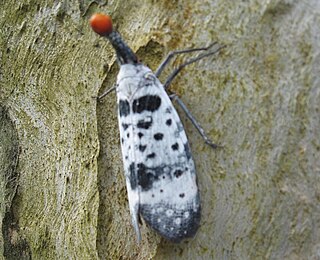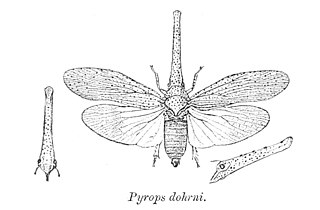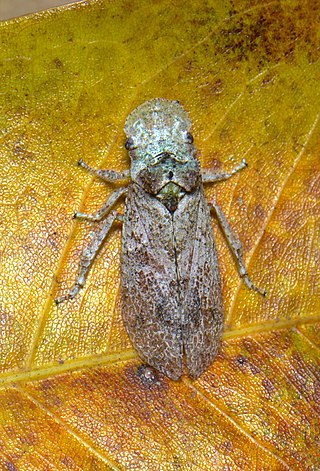
The family Fulgoridae is a large group of hemipteran insects, especially abundant and diverse in the tropics, containing over 125 genera worldwide. They are mostly of moderate to large size, many with a superficial resemblance to Lepidoptera due to their brilliant and varied coloration. Various genera and species are sometimes referred to as lanternflies or lanthorn flies, though they do not emit light.

Delphacidae is a family of planthoppers containing about 2000 species, distributed worldwide. Delphacids are separated from other "hoppers" by the prominent spur on the tibia of the hindleg.

Pyrops candelaria is a species of planthopper often placed in the tribe Laternariini. This species has been recorded from: Guangdong, Guangxi, Cambodia, Vietnam, Hong Kong, Laos, Thailand and other parts of southeast Asia. It is the type of the genus Pyrops erected by Spinola in 1839.

Pyrops is a genus of planthoppers that occur primarily in southeast Asia, containing about 70 species. They are fairly large insects, with much of the length due to an elongated, upcurving, snout-like projection of the head. The wings are generally brightly patterned in contrasting colors, and they are popular among collectors.

The subfamily Aphaeninae is a group of hemipteran insects, especially abundant and diverse in the tropics. They belong to the Fulgoridae (fulgorids), though they are not among the better-known members of that family that are called "lantern bugs" or "lanternflies". In 2009, the first molecular analysis of the Fulgoridae challenged the existing structure of eight currently recognized subfamilies and eleven tribes.

Acanalonia is a genus of planthopper and contains the majority of the species within the family Acanaloniidae. Species have been recorded from southern Europe and the Americas.

Flatidae are a family of fulgoroid planthoppers. They are cosmopolitan in distribution and are distinguished from others in the superfamily by a combination of characters. Like all other planthoppers, they suck phloem sap of plants. Some species are known to communicate with vibrations through the plant stems. Communication may be with mates, or with ants that tend the nymphs, protecting them and gathering honeydew secretions. Adults of some species have brightly coloured forewings which are tougher and known as tegmina unlike the membranous hindwings which are used for flight. Although a few can be identified by their coloration, most species requires dissection and examination under a microscope with access to literature on already described species.

Issidae is a family of planthoppers described by Spinola in 1839, belonging to the order Hemiptera, suborder Auchenorrhyncha superfamily Fulgoroidea.

Pyrops clavatus is a species of true bug in the family Fulgoridae, in the genus Pyrops which are sometimes called "lanternflies". This species is found in parts of northern and northeastern India, Myanmar, northern Thailand, southern China and northern Vietnam. The tip of the elongated head capsule is spheroidal, shiny and chestnut in colour while the remainder of the process is black with fine white spotting. The forewing has a variable patterning of black, grey and white. The hindwing is purplish white with the apical half black. Specimens have been obtained along the Himalayas west to Mussoorie but more often in Assam, Sikkim, Shillong and the Khasi Hills.

Zanna is a genus of tropical planthoppers found in Asia and Africa, now belonging to the monotypic subfamily Zanninae.

Ledrinae is a relatively small subfamily within the very large and diverse leafhopper family Cicadellidae. Originally placed in its own family, the "Ledridae", it is based on the type genus Ledra.

Lophopidae is a family of fulgoroid plant-hoppers with most species found in tropical South America and Asia.

Calyptoproctus is a genus of planthoppers in the family Fulgoridae and the type genus of subtribe Calyptoproctina; records are from Central and South America.

Delphacinae is a subfamily of delphacid planthoppers in the family Delphacidae. There are at least 1,700 described species in Delphacinae.

Achilidae is a family of planthoppers, sometimes called "achilids" in the order Hemiptera. There are at least 520 described species in Achilidae.

Thionia is a genus of planthoppers in the family Issidae. There are at least 60 described species in Thionia. However, several genera have been split off from Thionia reducing the number of species.

Dictyopharinae is a subfamily of dictyopharid planthoppers in the family Dictyopharidae. There more than 100 genera and 500 described species in Dictyopharinae.

The subfamily Poiocerinae include Hemipteran insects in the family Fulgoridae, found especially in the tropics.

The Flatinae are a subfamily of planthoppers, erected by Maximilian Spinola in 1839. Genera have been recorded from all continents except Antarctica: especially in tropical and subtropical regions.

The Nogodininae are a sub-family of tropical planthoppers erected by Leopold Melichar in 1898. The recorded distribution is: South America, Africa and the Middle East, South and SE Asia through to Australia.

























